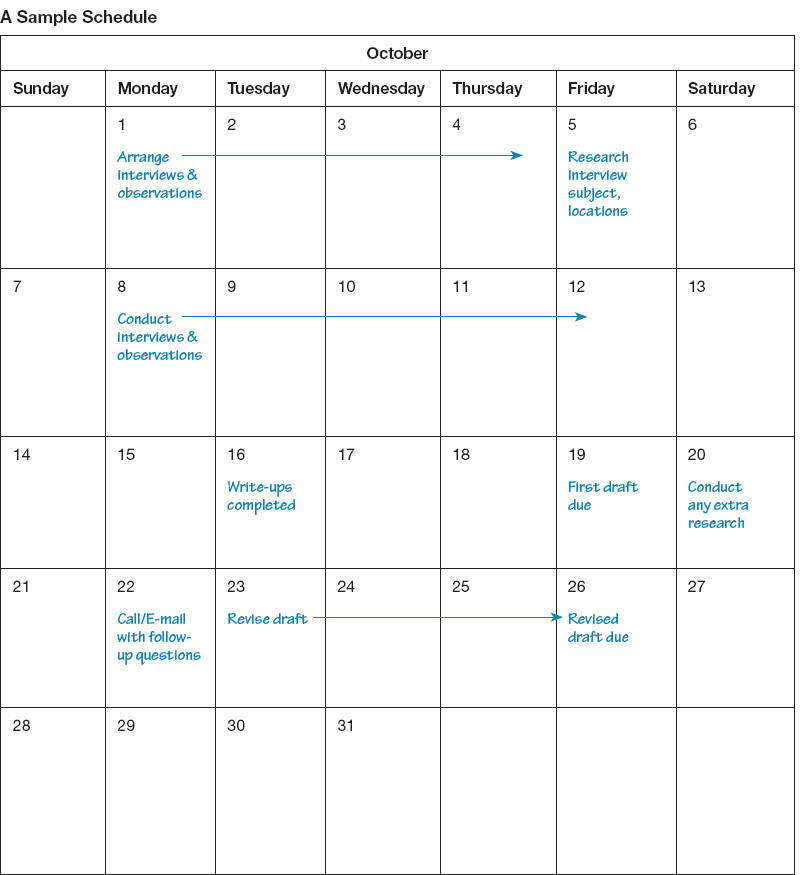Conduct your field research.
To learn more about conducting observations and making interviews, see Chapter 24.
To write an effective profile, you must conduct field research—interviews and observations—to collect detailed, firsthand information about your subject. The following activities will help you plan and carry out your field research.
Many writers begin with observations to get the lay of the land and identify people to interview, but you can start with interviews. You may even be able to make observations and conduct interviews during the same visit. Regardless of how you start your field research, come prepared: Dress appropriately, and bring preliminary questions and equipment for taking notes (be sure to ask permission before recording or filming).
Ways In
How Can I Manage My Time?
One of the best strategies for scheduling your time so that everything gets done by your deadline is backward planning.
- Buy or make a calendar (in print or online).
- Write the date the project is due and any other interim due dates (such as the date that your first draft is due) on the calendar. (Some writers like to give themselves a personal due date—the day before the official due date—so they have some wiggle room.)
- Move backward through the calendar, writing in due dates for other parts of the project:
- Interview and observation write-ups completed (organize your scribbled and abbreviated notes into logical categories, add reflections or additional thoughts, and type your notes in complete sentences)
- All field research completed
- Follow-up observations or interviews completed
- Initial interviews and observations conducted (leave at least a week for this process)
- Interviews and observations scheduled (leave at least several days for this process)

Ways In
How Do I Set Up and Prepare for Interviews and Observations?
- Make a list of people you would like to interview or places you would like to observe. Include a number of possibilities in case your first choice doesn’t work out.
- Write out your intentions and goals, so you can explain them clearly to others.
- Call or e-mail for an appointment with your interview subject, or make arrangements to visit the site. Explain who you are and what you are doing. Student research projects are often embraced, but be prepared for your request to be rejected.
Note: Be sure to arrange your interview or site visit as soon as possible. The most common error students report making on this assignment is waiting too long to make that first call. Be aware, too, that the people and places you contact may not respond immediately (or at all); be sure to follow up if you have not gotten an answer to your request within a few days.
- Make notes about what you expect to learn before you write interview questions, interview your subject, or visit your site. Writing a paragraph or two responding to the following questions might help:
| Interview | Observation |
|
|
|
|
|
|
|
|
|
|
- Write some interview questions in advance, or ask yourself some questions to help you determine how best to conduct the observation.
| Interview | Observation |
Ask for stories:
|
Should I observe from different vantage points or from the same location?Should I visit the location at different times of day or days of the week, or would it be better to visit at the same time every day?Should I focus on specific people, or should I identify roles and focus on people as they adopt those roles? |
- Conduct some preliminary research on your subject or related subjects if possible, and revise your questions or plans accordingly.
|
How Do I Conduct Interviews? |
How Do I Conduct Observations? |
| Take notes | Take notes |
|
|
| Reflect on the interview | Reflect on your observations |
Review your notes for five minutes after the interview. Focus on first impressions. Mark promising material, such as
|
Take five minutes right after your visit to think about what you observed, and write a few sentences about your impressions of the subject:
|
| Write up your interview | Write up your observations |
| Write a few paragraphs, deciding what to quote, summarize, paraphrase, or omit. Describe the person’s tone of voice, gestures, and appearance, as well as details you noticed about the place. You may use some of this material later in your draft. If your interviewee said you could follow up to check facts, e-mail or call with requests for clarification or questions. | Write a few paragraphs reporting on your visit. This write-up may produce language you can use in your draft. It will also help you think about how to describe your subject, what dominant impression you want to create, and the perspective your profile should take. |
|
Consider another interview |
Consider a follow-up observation |
| You might also arrange to talk to another person who has different kinds of information to share. | Consider a follow-up visit, possibly combined with an interview. Examine other aspects of the place or activity, and try to answer questions you still have. Does the impression you had on the first visit still hold? |